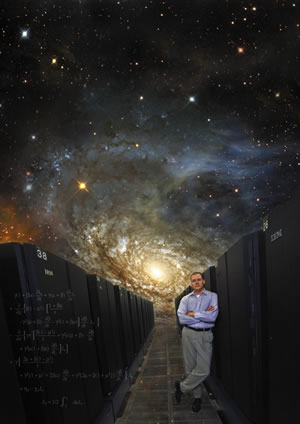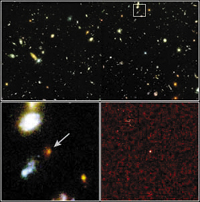|
|
 |
 |
| |
|
| |
In collaboration with other researchers,
physicist Peter Nugent uses Deep Field galaxy observations
from the Hubble Space Telescope, along with his own calculations
and the raw computing power of NERSC, to study dark energy
in the universe. |
| |
|
Good evidence that we live in an accelerating universe mostly
filled with dark energy," is how astrophysicist Peter
Nugent of NERSC's Scientific Computing Group characterizes
the remarkable supernova dubbed SN 1997ff. Working with Adam
Riess of the Space Telescope Science Institute (STScI), Nugent
confirmed that 1997ff was a Type Ia supernova, the kind of
bright, uniform event cosmologists use as "standard candles."
By comparing brightness and redshifts of Type Ia's, two international
groups of astronomers and physicists --the Supernova Cosmology
Project based at Berkeley Lab, of which Nugent is a member,
and the High-Z Supernova Search Team, to which Riess belongs--discovered
the universe's accelerating expansion, which they announced
in 1998.
If expansion were slowing down or coasting, the highest-redshift
Type Ia's they recorded should have been brighter; the researchers
concluded that expansion must be accelerating instead. They
were soon challenged by skeptics who tried to explain why
distant supernovae looked dimmer than they really were.
One idea was that "gray dust" fills space and, like
a neutral density filter, cuts the light from far-off objects.
Another suggestion held that, since the early universe was
poor in heavy elements, ancient exploding stars were dimmer
because of their chemistry.
"But SN 1997ff is so far away, and thus so old, that
it brings us information from an era when stars and galaxies
were closer together and expansion was still slowing due to
gravity," Nugent explains. "Cosmology turns things
around a bit when we look that far back: things don't get
as faint as quickly as they do at lower redshift. This was
the case for 1997ff-effectively arguing against the notion
that observations of distant Type Ia supernovae are systematically
distorted by intervening gray dust or the chemical evolution
of the universe, which would always make things fainter and
fainter."
SN 1997ff was first found by Ron Gilliland of STScI and Mark
Phillips of the Carnegie Institution of Washington during
the last week of December, 1997, while searching for high-redshift
supernovae in the Hubble Deep Field patch of galaxies. Sifting
the data, they found two good candidates and asked Nugent
to help them determine what this implied about the number
of high-redshift supernovae in the universe as a whole.
|
|
 |
|
| |
 |
Supernova 1997ff was discovered in
a tiny corner of the Hubble Deep Field of galaxies.
|
|
| |
|
Unfortunately SN 1997ff had been observed in only one range
of frequencies. Spectra of high redshift objects are shifted
well into the infrared, and without additional infrared observations
not even its type could be confirmed. It seemed unlikely that
anyone had made such observations.
Enter serendipity. Only 25 days after Gilliland and Phillips
made their search, Rodger Thompson of the University of Arizona
imaged part of the Hubble Deep Field in the near infrared.
Thompson wasn't looking for supernovae, but many of his images
accidentally included SN 1997ff and its host galaxy.
"Twenty-five days may seem like a long time, but highly
redshifted objects are moving away from us so fast that time
dilation is large," Nugent remarks. "At a redshift
of 1.7, three and a half weeks in our frame of reference is
only about nine days of elapsed time for the supernova itself."
In mid-1998 Mark Dickinson of STScI again caught infrared
images of the greatly faded supernova and its host galaxy.
Once more luck had provided a missing piece of the puzzle:
Nugent proposed to Dickinson that by digitally subtracting
the new images of the host galaxy from those made when the
supernova was bright, remaining uncertainties could be eliminated.
Meanwhile Adam Riess had become intrigued by the accumulating
data, and in July of 2000 he queried Nugent about doing cosmology
on an unnamed supernova at a redshift "around 1.65."
There was only one such supernova. "I guess I wasn't
especially cagey," Riess later admitted.
Soon Riess and Nugent were collaborating. Among the numerous
calculations Nugent performed at NERSC in communication with
Riess, one of the most telling was a set of plots establishing
that SN 1997ff was almost certainly a Type Ia supernova at
a redshift of 1.7, first seen eight days after it exploded.
"Now we could do the cosmology," Nugent says: it
pointed to a universe consisting of about one third matter
and about two thirds dark energy, acting to offset gravity.
Nugent says, "The results from SN 1997ff are one of the
best arguments for the SNAP satellite"--the proposed
SuperNova/ Acceleration Probe-- "because a supernova
at redshift 1.7 is too far away to be visible from the surface
of the Earth. Only a space-based telescope could have found
it."
By discovering many more such supernovae, SNAP could resolve
the most basic cosmological questions, including the nature
of the dark energy itself.
-- Paul Preuss
|



